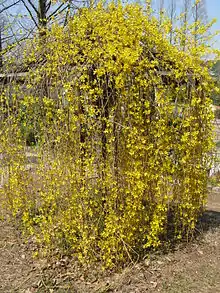| Forsythia suspensa | |
|---|---|
 | |
| Scientific classification | |
| Kingdom: | Plantae |
| Clade: | Tracheophytes |
| Clade: | Angiosperms |
| Clade: | Eudicots |
| Clade: | Asterids |
| Order: | Lamiales |
| Family: | Oleaceae |
| Genus: | Forsythia |
| Species: | F. suspensa |
| Binomial name | |
| Forsythia suspensa | |
| Synonyms[2] | |
| |

Forsythia suspensa, commonly known as weeping forsythia[3] or golden-bell,[4] is a species of flowering plant in the family Oleaceae, it is native to China.[2]
Taxonomy
The Latin epithet of suspensa is derived from suspensus meaning suspended.[5] It was first described and published in Enum. Pl. Obs. Vol.1 on page 39 in 1804.[2]
Description
Forsythia suspensa is a deciduous shrub that grows up to 3 metres (9.8 feet) tall. Its flowers are golden-yellow and they bloom March to April.[2] Leaves are green in color, broadly-ovate, and simple.[2]
It can be grown as a weeping shrub on stream banks and can be identified by its pale flowers. Garden cultivars can be found. It is a spring flowering shrub, with yellow flowers. It is grown and prized for its toughness.[6] Before Forsythia × intermedia was known as a true wild Chinese species, F. suspensa was considered one of its parents.[2]
Distribution and habitat
Forsythia suspensa is native to China. It is introduced in Japan, Spain, Bulgaria, Czechoslovakia, Korea, as well as some parts of the United States.[2] It grows in thickets or grassy areas on slopes and valleys.[7]
Uses
It is one of the 50 fundamental herbs used in traditional Chinese medicine.[8] It contains the lignans Pinoresinol[9] and phillyrin. The main active component isolated from Forsythia Fructus (the dried fruit of Forsythia suspensa), forsythiaside A, exhibits significant activities in treating various diseases, including inflammation, virus infection, neurodegeneration, oxidative stress, liver injury, and bacterial infection.[10]
References
- ↑ "Forsythia suspensa". Germplasm Resources Information Network. Agricultural Research Service, United States Department of Agriculture. Retrieved 2008-02-06.
- 1 2 3 4 5 6 7 "Forsythia suspensa (Thunb.) Vahl | Plants of the World Online | Kew Science". Plants of the World Online. Retrieved 11 September 2021.
- ↑ USDA, NRCS (n.d.). "Forsythia suspensa". The PLANTS Database (plants.usda.gov). Greensboro, North Carolina: National Plant Data Team. Retrieved 19 January 2016.
- ↑ BSBI List 2007 (xls). Botanical Society of Britain and Ireland. Archived from the original (xls) on 2015-06-26. Retrieved 2014-10-17.
- ↑ Lewis, Charlton (1891). An Elementary Latin Dictionary. Oxford: Oxford University Press. ISBN 9780199102051.
- ↑ Royal Horticultural Society (Great Britain) (1992). The New Royal Horticultural Society Dictionary of Gardening. Macmillan Press. ISBN 978-1-56159-001-8.
- ↑ "Forsythia suspensa in Flora of China @ efloras.org". www.efloras.org. Retrieved 2022-08-11.
- ↑ "Forsythia suspensa - Plants For A Future database report". Retrieved 2008-02-06.
- ↑ Davin, Laurence B.; Bedgar, Diana L.; Katayama, Takeshi; Lewis, Norman G. (1992). "On the stereoselective synthesis of (+)-pinoresinol in Forsythia suspensa from its achiral precursor, coniferyl alcohol". Phytochemistry. 31 (11): 3869–3874. Bibcode:1992PChem..31.3869D. doi:10.1016/S0031-9422(00)97544-7. PMID 11536515.
- ↑ Gong, L., Wang, C., Zhou, H., Ma, C., Zhang, Y., Peng, C., & Li, Y. (2021). "A review of pharmacological and pharmacokinetic properties of Forsythiaside A". Pharmacological Research, 169, 105690. PMID 34029711 doi:10.1016/j.phrs.2021.105690
External links
 Media related to Forsythia suspensa at Wikimedia Commons
Media related to Forsythia suspensa at Wikimedia Commons Data related to Forsythia suspensa at Wikispecies
Data related to Forsythia suspensa at Wikispecies- Forsythia - Forsythia suspensa, species information page - at Brickfields Country Park.
- Forsythia suspensa page Archived 2008-05-13 at the Wayback Machine